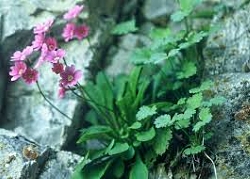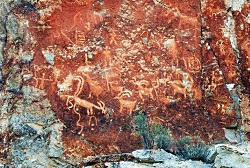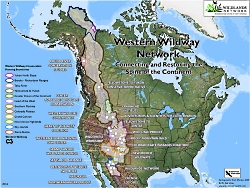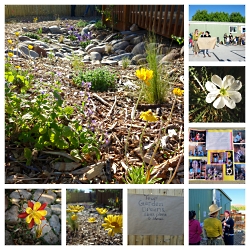
Moab Charter School
Photo Courtesy & © Roslynn Brain, Photographer
 Before and After
Before and After
Permaculture Rain Garden
USU Moab
Photo Courtesy & © Roslynn Brain, Photographer
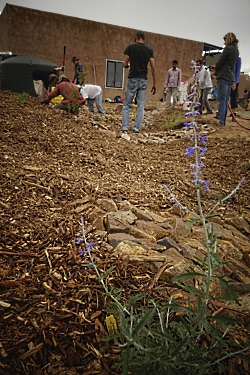 Rain Tank with
Rain Tank with
Basins and Overflow Swales
Albuquerque Open Space Visitor Ctr
Photo Courtesy & © Roslynn Brain, Photographer
 Rain Water Storage Tank
Rain Water Storage Tank
Private Residence in New Mexico
Installed by Jeff Adams of Terrasophia
Photo Courtesy & © Roslynn Brain, Photographer
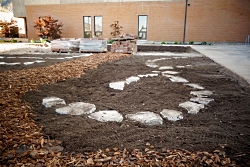 Development
Development
Permaculture Rain Garden
USU Logan
Photo Courtesy & © Roslynn Brain, Photographer
A common saying in the west is “Whiskey is for drinkin’ and water is for fightin.’” As drought forecasts and associated water scarcity grow, many are turning towards water harvesting as a way to not only save money, but to also be more self sufficient. In Utah, thanks to a revised House Bill 36 in 2013, residents on any parcel of land can install a rainwater harvesting system and use that water on the same parcel. The total volume of rainwater that can be harvested is 2,500 gallons. Containers are recommended to be covered, primarily to reduce mosquito outbreaks, and can be above or below ground.
So how do you go about installing a rainwater harvesting system?
First, analyze your landscape and estimate your water needs by doing a water budget calculation. The Environmental Protection Agency’s WaterSense program has a landscape water budget tool that you can use to help determine your water needs. This is calculated as gallons per month based on your landscaped area, plant types, and associated water demand per plant type. In Brad Lancaster’s book, Rainwater Harvesting For Drylands and Beyond volume 1, you can find formulas for calculating how much rainwater your roof can yield, based on yearly or monthly rainfall. This can also be found in USU Extension’s permaculture fact sheet. Once you have these two numbers – your approximate landscape water demand, and the approximate rainwater your roof can provide per year, you can better estimate a practical size for your rainwater container – also called a tank or cistern. Also consider the room you have, likelihood of using harvested water, and ease of use, in addition to your landscape needs.
Now you are ready to either purchase or build your rainwater harvesting system. Remember, each tank needs an overflow and that overflow should ideally be aimed towards plants with higher water needs. For recommendations on how to install and or build rainwater harvesting containers in Utah search “Rain Barrels in Utah” through USU Extension.
If you are putting in new landscaping, search Water Harvesting Earthworks for ideas of how to design in a way that best slows, spreads, and sinks rainwater. Or look up “Plant the Water before the Tree” by the Watershed Management Group as a starting point.
No matter what size of tank you choose to install, the beauty lies in actually using harvested water from your tank, especially during periods of drought.
As watershed management consultant Jeff Adams says, “It is what you can fill, fit and afford based on your patterns of use.”
This is Roslynn Brain of Utah State University Extension Sustainability.
Credits:
Images: Courtesy & Copyright Roslynn Brain, Photographer
Text: Roslynn Brain, Extension.usu.edu
Additional Reading:
Watersense, Environmental Protection Agency https://www3.epa.gov/watersense/
Lancaster, Brad, Rainwater Harvesting Drylands and Beyond, https://www.amazon.com/Rainwater-Harvesting-Drylands-Beyond-2nd/dp/0977246434/ref=sr_1_1?s=books&ie=UTF8&qid=1445316738&sr=1-1&keywords=rainwater+harvesting+for+drylands+and+beyond
Plant the Water Before the Tree – Help Your Tree Grow and Thrive with Rainwater!, Watershed Management Group, https://watershedmg.org/document/plant-water-tree-help-your-tree-grow-and-thrive-rainwater
Rain Barrels in Utah, USU Extension, https://digitalcommons.usu.edu/cgi/viewcontent.cgi?article=1746&context=extension_curall
YCC Team, Lush Utah garden makes the most of a small amount of rain, Yale Climate Connections, July 25, 2022, https://yaleclimateconnections.org/2022/07/lush-utah-garden-makes-the-most-of-a-small-amount-of-rain/

